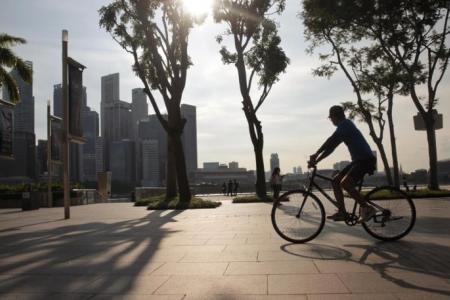Why has it been so hot in S'pore and how will climate change affect conditions?
High humidity can irritate but combine that with low wind speeds, for example, and it will get even more uncomfortable.
Weather scientists say that explains why it can feel hotter than what the thermometer may be showing.
But the mercury in Singapore did hit new highs over the last two months, with the Republic recording the second highest temperature on April 1 at 36.8 deg C.
More recently, people here had to endure the highest temperature for May in Singapore - a sweltering 36.7 deg C recorded on May 13.
The Straits Times speaks to experts to learn about the factors that influence how people feel the heat, and whether climate change could worsen things.
Q: What factors can make a hot day in Singapore feel worse?
A: Light wind conditions, high humidity, and Singapore's highly urbanised environment can all contribute.
During the inter-monsoon periods of April and May, and from October to November, people are more inclined to feel the heat due to light and variable surface winds, noted Associate Professor Koh Tieh Yong.
Such conditions mean heat cannot be removed by ventilation, added Prof Koh, a weather and climate scientist from the Singapore University of Social Sciences.
Because of intense sunshine near the equator, water from Singapore's surrounding seas evaporates at a high rate.
The moisture-laden air is carried to Singapore in the afternoon and evening by sea breezes, making the city humid, Prof Koh said.
The average annual relative humidity in Singapore is 83.9 per cent, and it often reaches 100 per cent during prolonged periods of rain, according to the National Environment Agency's Meteorological Service Singapore (MSS) website.
In comparison, the annual average relative humidity in Los Angeles is between 54 and 58 per cent.
When relative humidity is high, the human body cannot lose heat easily by evaporating sweat, making it more uncomfortable and seemingly warmer, said Prof Koh.
Increases in temperature are more keenly felt in cities like Singapore due to the urban heat island effect.
This occurs when heat is trapped by urban surfaces such as concrete and asphalt, and from waste heat generated by air-conditioning and motor vehicles, said Associate Professor Winston Chow.
This is especially felt at night, when heat stored by the built environment during the day is released, added Prof Chow, an associate professor of Science, Technology and Society at the Singapore Management University .
For example, in a study he recorded a temperature of 30 deg C at Orchard Road at 10pm as compared with 23 deg C in Lim Chu Kang's forest at the same time.
Q: Is it hotter in certain parts of Singapore?
A: People in the north are more prone to experience scorching temperatures during the inter-monsoon months, data by the MSS has shown.
Admiralty logged a new record for May at 36.7 deg C, surpassing the previous record high for the month of May of 36.5 deg C in 2010 and 2016.
It also hit the second highest temperature recorded in Singapore on April 1.
Said Prof Koh: "Among the urban areas in Singapore, north Singapore lies furthest away from the Singapore Strait and gets the least of the cooling sea breezes.
"So compounded by the daytime urban heat sources, north Singapore is more prone to high temperatures in the day during the inter-monsoon periods."
The Singapore Strait is the water body that lies south of the mainland, and is a much larger body of water compared to the narrow Johor Strait in the north.
Q: Will climate changemake hot days worse?
A: Global temperatures are expected to rise further due to climate change, which means Singapore is likely to set new temperature records in the coming months, experts say.
It is already warming faster than the global average, and temperatures here are already 1.8 deg C higher than they were in 1948.
In contrast, global temperatures have risen by about 1.1 deg C from pre-industrial times, which ended around 1850.
Global warming could be amplified over Singapore's fully urbanised land, because concrete heats up and cools down quicker than water, and this makes the country heat up easily, said geographer and weather scientist Wang Jingyu from the Nanyang Technological University.
In theory, warmer global temperatures could also increase the ability of air to hold more water vapour, increasing humidity, said Prof Chow.
However, this is still an area being studied.
Observations across the world so far do not indicate any consistent long-term trend in relative humidity associated with climate change, said Prof Koh.
Q: What is wet-bulb temperature and why does it matter?
A: Wet-bulb temperatures combine temperature and relative humidity, reflecting the human body's ability to cool down in hot and humid conditions.
It shows the lowest temperature that air can be cooled down through the evaporation of water.
The lower the wet-bulb temperature, the easier it is for bodies to cool down.
Sweating cools us down but high humidity can make it harder for sweat to evaporate, reducing the body's ability to cool itself.
Wet-bulb temperatures are on the rise around the world, with 35 deg C deemed as the theoretical limit for human survival, according to Nasa's Climate Change News.
The average wet bulb temperatures measured at the Changi Climate Station in April and May so far have been lower than the average temperatures for those months, according to MSS.
In April, the average wet bulb temperature was 25.4 deg C, which was 0.4 deg C lower than the normal temperature in April for the past 30 years.
Meanwhile, May recorded an average wet bulb temperature of 25.9 deg C, which is 0.3 deg C below the monthly average for May over the same period.
While wet bulb temperatures over the past 40 years have increased by 0.06 deg C per decade, this is "non-statistically significant", said MSS.
Said Prof Chow: "Even if you are the fittest person, no human being can sustain activity outdoors at a wet bulb temperature of 35 deg C without being at high risk of heat stroke."
The month of May has the highest average wet bulb temperature, followed by June, MSS said.
Get The New Paper on your phone with the free TNP app. Download from the Apple App Store or Google Play Store now


